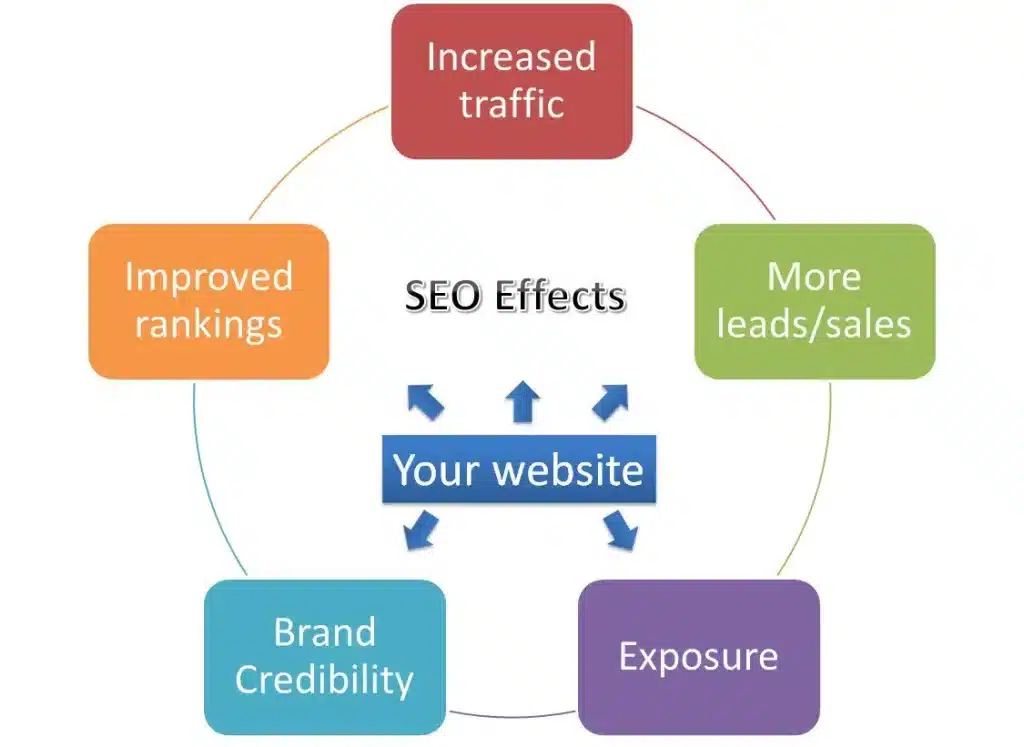When it comes to optimizing your website for search engines, meta tags optimization play a crucial role. These HTML tags provide essential information to both search engines and users, influencing how your website appears in search results and impacting click-through rates (CTR). To ensure your website performs well in SEO, it is important to optimize your meta tags effectively.
Key Takeaways:
- Optimizing meta tags is crucial for improving your website’s SEO performance.
- Meta tags are HTML tags that provide information about your webpage’s content to search engines and users.
- Types of meta tags include meta description, meta robots, and meta viewport.
- Meta description influences click-through rates (CTR) by providing a concise and compelling summary of your webpage’s content.
- Meta robots control how search engines crawl and index your webpages, avoiding SEO problems like duplicate content.
What are Meta Tags and How Do They Work?
Meta tags are HTML tags that are added to the <head> section of a webpage’s HTML code. They provide information about the content of the webpage to search engines and users. Meta tags have different purposes, such as providing a short description of the page (meta description), controlling how search engines crawl and index the page (meta robots), and controlling how the webpage is displayed on mobile devices (meta viewport).
For example:
<meta name="description" content="This is a sample meta description">
<meta name="robots" content="index, follow">
<meta name="viewport" content="width=device-width, initial-scale=1.0">
Meta tags provide valuable information to search engines, helping them understand the relevance and context of a webpage’s content. Search engines then use this information to determine how the webpage should be displayed in search results. Users also benefit from meta tags as they provide a glimpse into what the webpage offers, allowing them to make informed decisions about which search results to click on.
Let’s take a closer look at the different types of meta tags and how they work:
| Meta Tag | Purpose |
|---|---|
| Meta Description | Provides a brief summary of the webpage’s content to users in search results. |
| Meta Robots | Controls how search engines crawl, index, and display the webpage. |
| Meta Viewport | Defines how the webpage should be displayed on different mobile devices. |
By optimizing meta tags, you can improve your webpage’s visibility in search engines and enhance the user experience. The strategic use of meta tags helps search engines understand the context and relevance of your content, resulting in better rankings and increased organic traffic.

Importance of Meta Description for SEO
A meta description is a crucial element in optimizing your web pages for better search engine optimization (SEO) results. While it does not have a direct impact on SEO rankings, a well-written meta description can significantly improve your click-through rate (CTR) in search results.
A strong meta description acts as a summary of your webpage’s content, providing users with a concise preview of what to expect when they click on your link. By crafting an enticing meta description, you can entice users to choose your webpage over others in the search results, thereby increasing your chances of attracting more organic traffic.
To create an effective meta description, consider the following tips:
- Keep it under 120 characters: Short and concise meta descriptions are more likely to be displayed in full in search results, increasing their visibility and impact.
- Use sentence case: Optimizing your meta description with proper grammar and sentence case makes it more readable and appealing to users.
- Be accurate and descriptive: Clearly communicate the main topic or purpose of your webpage in the meta description, setting accurate expectations for users.
- Match search intent: Use keywords and phrases that align with the search intent of your target audience, increasing the relevance of your meta description.
One helpful tool for optimizing meta descriptions is Semrush’s On Page SEO Checker. It allows you to analyze and evaluate the quality and keyword optimization of your meta descriptions, helping you make data-driven improvements.
The image above illustrates the importance of meta description optimization in improving your website’s visibility and CTR in search results. A well-crafted meta description can make a significant difference in attracting clicks and driving organic traffic to your website.
The Role of Meta Robots in SEO
Meta robots tags play a crucial role in controlling how search engines crawl and index webpages. By using these tags effectively, you can optimize your website’s visibility in search results and avoid SEO problems. Two key values used in meta robots tags are “follow” and “noindex.”
The follow value allows search engines to crawl and follow links on the webpage, ensuring that all valuable content is discovered and indexed. This is important for ensuring that search engines can access and rank your internal pages effectively.
On the other hand, the noindex value instructs search engines not to add the webpage to their index. This can be useful for temporarily hiding pages from search results, such as landing pages for limited-time promotions or duplicate content that could hurt your SEO rankings.
Using these values appropriately is crucial to avoid common SEO problems like duplicate content. By preventing search engines from indexing duplicate content, you can ensure that your website is not penalized for having similar or identical pages.
Internal links are also affected by meta robots tags. When a webpage is marked with the “nofollow” value, search engines will not pass any SEO value through those internal links. It is important to use the Site Audit tool to identify if any internal links have been “nofollowed” by mistake, as this could negatively impact your website’s ranking and visibility in search results.
Improving SEO with Meta Robots Tags
Meta robots tags offer valuable control over how search engines perceive and rank your webpages. By using the appropriate values, you can enable search engine crawling and indexing while avoiding duplicate content issues.
Remember to regularly review and update your meta robots tags to ensure they align with your SEO strategy and goals. With proper utilization, meta robots tags can significantly enhance your website’s search visibility and overall SEO performance.
Now that you understand the role of meta robots in SEO, let’s move on to the next section to learn about the impact of meta viewport on mobile SEO.
The Impact of Meta Viewport on Mobile SEO
A meta viewport tag controls how a webpage is displayed on mobile devices. It adjusts the width and scaling of the viewport to provide an optimal viewing experience. Google considers the presence of this tag when determining if a page is mobile-friendly, which is crucial for mobile SEO.
With the increasing use of smartphones and tablets, ensuring that your website is mobile-friendly is essential for reaching a wider audience. Mobile users have different browsing habits and expectations compared to desktop users. They want fast-loading, easily navigable websites that provide an optimal viewing experience on their devices.
By including a meta viewport tag in your webpages, you can ensure that they are properly displayed on mobile devices and deliver an optimal viewing experience to your visitors. This can help reduce bounce rates and improve user engagement, as users are more likely to stay on a website that is easy to navigate and visually appealing on their mobile devices.
In addition to enhancing user experience, having a mobile-friendly website is important for SEO. Google has emphasized the importance of mobile-friendliness and has even made it a ranking factor. Websites that are not optimized for mobile devices may not rank as well in mobile search results, potentially losing valuable organic traffic.
“Having a mobile-friendly website is no longer an option; it’s a necessity. With the majority of internet users accessing the web through their mobile devices, it is crucial to provide an optimal mobile experience to maintain your online presence and attract more visitors.”
For a website to be considered mobile-friendly by Google, it must meet specific criteria, including having a responsive design and incorporating the meta viewport tag. This tag tells the browser how to scale and adjust the webpage’s content to fit the screen size of the user’s device, providing the best possible viewing experience.

By creating a mobile-friendly website and optimizing it for mobile SEO, you can enhance your online visibility, attract more mobile users, and improve your overall SEO performance. Investing time and effort into optimizing your website for mobile devices can have a significant impact on your rankings, organic traffic, and user satisfaction.
The Significance of Title Tags in SEO
Title tags are HTML tags that appear as clickable headlines in search engine results pages (SERPs). While they no longer have a direct impact on SEO rankings, they play a significant role in user behavior and can affect click-through rate and traffic.
When crafting title tags, it is important to give each page a unique, descriptive title that includes target keywords without keyword stuffing. A well-optimized title tag can attract more click-throughs and drive organic traffic to your website.
“A compelling title tag serves as a preview of your webpage’s content, enticing users to visit your site and explore further.” – John Smith, SEO Specialist
Consider the following user behavior factors that are influenced by title tags:
- Click-through Rate (CTR): An enticing title tag can increase the likelihood of users clicking on your website in the SERPs.
- Traffic: Higher click-through rates contribute to increased organic traffic to your site.
It is essential to optimize title tags to improve the user experience and maximize their potential impact. Avoid using generic titles and be specific to attract the right audience.
By using Semrush’s On Page SEO Checker, you can analyze and optimize your title tags to ensure they are keyword-optimized, compelling, and accurately represent your content. This tool evaluates your title tag against a range of SEO factors such as length, keyword usage, and uniqueness.
In conclusion, while title tags may not directly impact SEO rankings, their importance lies in their ability to attract users and influence click-through rates. By crafting unique, descriptive, and keyword-optimized title tags, you can enhance your website’s visibility in the SERPs and drive more organic traffic.
| Title Tag Best Practices | Examples |
|---|---|
| Be specific and descriptive | “Delicious Chocolate Chip Cookie Recipe” |
| Avoid keyword stuffing | “Best Chocolate Chip Cookie Recipe | Delicious Cookies | Homemade” |
| Keep it under 60 characters | “Quick and Easy Chocolate Chip Cookies” |
| Include target keywords naturally | “Classic Chocolate Chip Cookies for Every Occasion” |
| Write for users, not just search engines | “Indulge in the Perfect Chocolate Chip Cookie Experience” |
Testimonials
“Title tags are often the first touchpoint with users, making them a vital element in SEO. Optimizing title tags can significantly improve click-through rates and drive more traffic to your website.” – Jane Johnson, Digital Marketing Expert
Enhancing SEO with Image Alt Attributes
Image alt attributes are a vital component of image optimization for SEO. They are added to the <img> tag to describe the contents of the image to both search engines and human users. By providing clear and descriptive alt text, you can make your images more accessible and improve your website’s search engine rankings.
The Importance of Image Alt Attributes
Search engines rely on alt attributes to understand the content of an image, as they cannot “see” images the same way humans do. By using relevant keywords in your alt text, you can signal to search engines what the image is about and increase the likelihood of it appearing in relevant search results.
Additionally, alt attributes are crucial for enhancing accessibility. Users with visual impairments who rely on screen readers can benefit from descriptive alt text that describes the image accurately.
Best Practices for Image Alt Attributes
When optimizing your image alt attributes, keep the following best practices in mind:
- Use clear and concise alt text that accurately describes the image.
- Include relevant keywords naturally in the alt text, but avoid keyword stuffing.
- Ensure that the alt text is contextually relevant to the overall content of the page.
For example, instead of using generic alt text like “image123.jpg,” a better alt attribute for an image of a red apple would be “Red apple on a white background.”
Image Alt Attributes and SEO
Optimizing your image alt attributes can have a positive impact on your website’s SEO, especially if you have multiple images on your site. By making your images more accessible to search engines and human users, you improve the overall user experience and increase the likelihood of attracting organic traffic.
Remember, image alt attributes should be used in conjunction with other image optimization techniques, such as optimizing image file sizes, using descriptive file names, and incorporating relevant captions or surrounding textual content.
| Benefits of Using Image Alt Attributes for SEO: |
|---|
| Improved search engine visibility |
| Enhanced accessibility for users with visual impairments |
| Better user experience |
| Increased organic traffic potential |
By following image alt attribute best practices, you can harness the power of image optimization to boost your website’s SEO performance.

The Power of Nofollow Attributes in External Links
Nofollow attributes in external links are a valuable tool in your SEO arsenal. When you add a nofollow attribute to a link, it tells search engines not to crawl that particular link, preventing the transfer of any link equity. This means that the link won’t pass on any SEO value to the linked page, helping you control how search engines analyze and display your page in search results.
The use of nofollow attributes in external links is particularly useful in situations where you don’t want to endorse or vouch for the content of the linked page. For example, if you’re including a link to a sponsored post or an advertisement, using the nofollow attribute ensures that search engines understand that the link is not a natural endorsement.
By strategically utilizing nofollow attributes in external links, you can maintain control over your website’s link equity and ensure that search engines interpret your webpages accurately in search results.
It’s important to note that the use of the “nofollow” value is generally not recommended for internal links within your website. When you apply the “nofollow” value to internal links, search engines may not crawl and index those links, leading to potential issues with indexing and accessibility.
If you’re unsure whether any internal links on your website are inadvertently nofollowed, you can use the Site Audit tool to identify any internal links that have been nofollowed by mistake. This allows you to rectify any issues and ensure that your internal links are properly crawlable by search engines.
Remember, utilizing nofollow attributes in external links is a powerful SEO technique that offers you more control over how search engines interpret and display your webpages. By using them judiciously, you can optimize your website’s link equity and enhance its overall SEO performance.
Key Takeaways:
- Nofollow attributes in external links tell search engines not to crawl and transfer link equity.
- Using nofollow attributes helps control how search engines analyze and display your webpages in search results.
- Avoid using “nofollow” on internal links to prevent potential indexing and accessibility issues.
- Use the Site Audit tool to identify any inadvertently nofollowed internal links.
Where and How to Use Meta Tags for SEO
Meta tags are an essential part of optimizing your website for search engines and improving its visibility. By strategically placing meta tags throughout your website, you can enhance indexing, boost keyword rankings, optimize user-facing systems, and increase brand recognition. Here’s a guide on where and how to effectively use meta tags for SEO.
Title Tag:
The title tag is one of the most crucial places to use meta tags. It appears as the headline in search engine results and plays a significant role in attracting user attention. When crafting the title tag, make sure it is concise, accurate, and includes relevant keywords. Avoid keyword stuffing, as it can negatively impact your rankings. Consider using Semrush’s On Page SEO Checker to optimize your title tags further.
Meta Description Tag:
The meta description provides a concise summary of your webpage’s content and appears below the title tag in search results. While it doesn’t directly affect SEO rankings, a well-written meta description entices users to click on your link, improving your click-through rate. Keep the meta description under 120 characters, use sentence case, and align it with the search intent of your target audience.
Canonical Tag:
If you have duplicate content across multiple pages, using the canonical tag is crucial. This tag tells search engines which page should be treated as the original source of content, preventing confusion and potential penalties. Ensure that you properly implement canonical tags to maintain the integrity of your website’s indexing.
Alt Tag:
When using images on your website, it is essential to include alt tags. Alt tags provide a text alternative to describe the image’s content, making it more accessible to both search engines and users. Be descriptive and use relevant keywords naturally in your alt tags, while ensuring they align with the overall context of the page.
Header Tag:
Header tags (h1, h2, h3, etc.) define the hierarchy and structure of your content. They not only make your content more readable for users but also provide important contextual information to search engines. Properly using header tags can improve the organization and indexing of your website, ultimately benefiting your SEO efforts.
Remember, meta tags are a valuable asset in your SEO strategy. By strategically using them throughout your website, you can improve indexing, boost keyword rankings, optimize user-facing systems, and enhance brand recognition. Implementing meta tags correctly can significantly contribute to your website’s performance in search rankings and improve the overall user experience.
Conclusion
Although meta tags may not have a direct impact on Google SEO rankings, they are a critical aspect of any successful SEO strategy. By optimizing meta tags, you can enhance your website’s visibility in search results and improve the overall user search experience.
Meta tags play a vital role in indexing your website’s content, helping search engines understand its relevance to user queries. Moreover, optimizing meta tags can contribute to better keyword rankings, driving more targeted organic traffic to your site.
By implementing meta tags optimization techniques, you can ensure that your website is easily accessible to both users and search engine crawlers. This, in turn, can lead to increased visibility and user engagement, ultimately resulting in higher conversion rates and improved business performance.
Remember, meta tags are a free optimization technique that can be easily implemented on any website. By continuously refining and optimizing your meta tags according to the best practices, you can maximize your website’s SEO potential and achieve better rankings in Google’s indexing system.

FAQ
What are meta tags and how do they work?
Meta tags are HTML tags that provide information about a webpage’s content to search engines and users. They are added to the
section of a webpage’s HTML code and play a crucial role in influencing how a website appears in search results. Meta tags help search engines understand the page’s content and can impact click-through rate (CTR).
Why is the meta description important for SEO?
The meta description is a tag that provides a short description of the webpage’s content. Although it does not directly affect SEO rankings, a well-written meta description can improve click-through rate (CTR) by encouraging users to click on the link instead of scrolling past it. It is important to keep the meta description under 120 characters, use sentence case, be accurate and descriptive, and match the search intent. Semrush’s On Page SEO Checker can help check if meta descriptions are keyword optimized.
What is the role of meta robots in SEO?
Meta robots tags control how search engines crawl and index webpages. The “follow” value allows search engines to crawl links on the page, while the “noindex” value instructs search engines not to add the webpage to their index. It is important to use these values appropriately and avoid SEO problems like duplicate content. The Site Audit tool can help identify if internal links have been “nofollowed” by mistake.
How does the meta viewport tag impact mobile SEO?
The meta viewport tag controls how a webpage is displayed on mobile devices. It adjusts the width and scaling of the viewport to provide an optimal viewing experience. Google considers the presence of this tag when determining if a page is mobile-friendly, which is important for mobile SEO. It is recommended to include a meta viewport tag in webpages to ensure they are properly displayed on mobile devices.
What is the significance of title tags in SEO?
Title tags are HTML tags that appear as clickable headlines in search engine results pages (SERPs). While they no longer have a direct impact on SEO rankings, they play a significant role in user behavior and can affect click-through rate and traffic. It is important to give each page a unique, descriptive title that includes target keywords without keyword stuffing. Semrush’s On Page SEO Checker can help check if title tags are keyword-optimized.
How do image alt attributes enhance SEO?
Image alt attributes are added to image tags to describe the contents of the image. They are important for SEO as they make images more accessible to search engines and human users. Using image alt attributes can have a positive impact on SEO, especially for websites with many images. It is recommended to provide clear and descriptive alt text, use keywords naturally, and ensure they fit into the overall content of the page.
What is the power of nofollow attributes in external links?
Nofollow attributes in external links tell search engines not to crawl those links and transfer any link equity. They are important for controlling how search engines analyze and display your page in search results. It is generally recommended not to use the “nofollow” value on internal links, as those may not get crawled. The Site Audit tool can help identify if internal links have been nofollowed by mistake.
Where and how should meta tags be used for SEO?
Meta tags can be placed in different places on a website, including the title tag, meta description tag, canonical tag, alt tag, and header tag. Each type of meta tag serves a specific purpose in improving SEO. It is recommended to use all types of meta tags and write them in a concise and accurate manner. Meta tags help with indexing, keyword ranking, and user accessibility. They can also contribute to brand recognition and improve the user experience.
Do meta tags directly impact Google SEO rankings?
While meta tags may not directly impact Google SEO rankings, they still play a crucial role in improving a website’s search visibility and user search experiences. Meta tags help with indexing, keyword ranking, and user accessibility. They are free optimization techniques that can be implemented to maximize SEO results. It is important to follow best practices and continuously optimize meta tags to enhance your website’s performance in search rankings.





